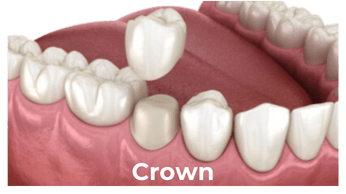Crown and Bridge
Crown
A dental crown is a protective cap used to restore the strength, shape and appearance of damaged tooth. It is often recommended for severely broken, cracked or decayed teeth, especially those that have undergone root canal treatment, particularly in the back teeth like premolars and molars.
There are different types of crown materials:
- Ceramic
- Zirconia
- PFM
- Metal

Bridge
Bridges consist of crowns on neighbouring teeth to secure a false tooth, offering benefits such as smile restoration, normal chewing and speaking, and preservation of facial shape.
There are different types of dental bridges:
- Traditional bridges: crowns on adjacent teeth with a bridge in between. They are not removable, look great, offer protection, and last long.
- Cantilever bridges: is supported by just one tooth next to the missing one. This involves placing the artificial tooth in the gap and attaching it to the healthy tooth on one side.
- Maryland bridges: supported by a metal framework, these have metal wings bonded to the back of existing teeth. They require minimal preparation of adjacent teeth, are relatively quick, and eliminate the need for surgical procedures.



Frequently Asked Questions
What is the procedure for a crown or bridge?
This treatment involves two appointments. During the first appointment, your dentist will numb the area with local anaesthetic then reshape the tooth or teeth, take an impression or 3D scan, and place a temporary crown or bridge. The second appointment includes the removal of the temporary crown or bridge and the cementing of the new crown or bridge onto the natural tooth structure.
How long does a crown or bridge take to make?
The procedure for a bridge is quite similar to that of a crown but takes more time due to the preparation of multiple teeth. Your dentist will provide information on the expected duration of the process.
Will the procedure hurt?
The procedure is performed under local anesthesia, so it is not anticipated to be painful during its preparation. There might be some tenderness and sensitivity in the tooth and gums afterward, but regular over-the-counter pain relief is typically sufficient to manage such discomforts.
How do various crown materials differ from each other?
E-max crowns, made of lithium disilicate, represent the latest in dental crown technology. Their advantages include excellent aesthetics, strength and durability for both front and back teeth. However, they are not recommended for bridges.
Zirconia crowns, blending metal strength with porcelain aesthetics, have gained popularity. Noteworthy advantages include excellent aesthetics, strength and durability. However, drawbacks include potential wear on opposing teeth and challenges in adjustment.
PFM crowns combine metal strength with porcelain aesthetics, offering durability and a proven track record of over 50 years at a more affordable cost than all-porcelain crowns. However, they may exhibit a visible grey line at the gum line, affecting aesthetics, and could wear down more easily in individuals who clench their teeth.
Gold crowns, composed of copper and other metals, are recognised for their strength and durability, making them ideal for back teeth. While they last a long time and require less removal of natural tooth structure, their unattractive appearance and distinctiveness from natural teeth contribute to their diminished popularity.
Contact Us
Get in touch
